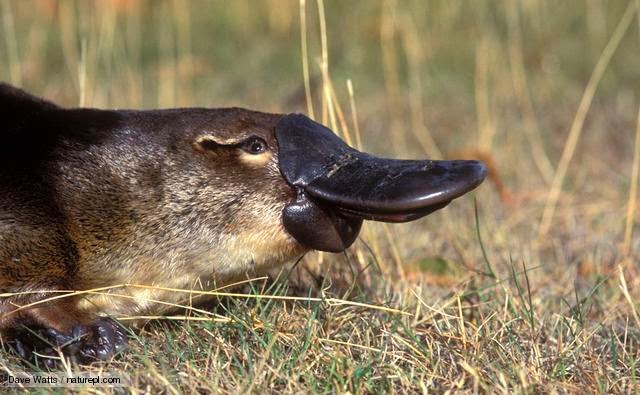鴨嘴獸(Ornithorhynchus
Anatinus)
鴨嘴獸(Platypus)雖然分類學家將牠歸類為
脊椎動物門
哺乳綱
單孔目,
但其實是一種典型的鑲嵌動物(mosaic animal):
1. 卵生、卵裂為盤裂(meroblastic cleavage)、雄鴨嘴獸後肢靠近
腳踝中空的距(hollow spur)具有毒腺→此為爬行動物之特
徵。
2. 無牙齒具有嘴喙(duck-billed)、具有泄殖腔(cloaca)→此為鳥類
之特徵。
3. 具有毛髮(fur)、乳腺(mammary
glands)、能調節體溫→此為哺乳
動物之特徵。
或者是說得更學術一點,鴨嘴獸是爬行類、鳥類、哺乳類之間的過渡型動物(transient animal)。
鴨嘴獸的棲所(habitat),在澳洲從水溫接近0℃的水域到亞熱帶的水域都有,但是鴨嘴獸都能調節代謝率以維持32℃的恆溫。
圖01. 鴨嘴獸的受精卵為盤裂(meroblastic cleavage)是魚類、爬行類(reptiles)、鳥類動物之卵裂方式(圖1-II)。
圖02.
鴨嘴獸具有毒腺能分泌毒液(venom)像爬行類;卵生像鳥類;哺乳(lactation)像哺乳類,是爬行類、鳥類、哺乳類之間的過渡型動物(transient
animal)。
圖03.
鴨嘴獸之嘴喙上有許多小孔,孔內具有兩種接受器:
1. 電流接受器(electroreceptors)─偵測牠所獵食的水中無脊椎動物幼蟲發出之微弱電流。
2. 機械接受器(mechanoreceptors)─偵測獵物引起的水波振動。
憑藉此兩種接受器,鴨嘴獸在水中雖然眼睛、鼻孔緊閉,仍能通行阻礙的覓食。而且鴨嘴獸是夜行性動物,在晚間視力的幫助也很有限。
圖04.
鴨嘴獸的一些特徵。
圖05. 雄性鴨嘴獸有蹼後腿上具有毒腺﹐利用鋒利的刺將毒液注入獵物(prey)或是與其競爭的雄性鴨嘴獸體內。
僅僅生活在澳洲東部(eastern Australia)的鴨嘴獸,是屬於哺乳綱單孔目的動物。
圖06. 深紫色標示的是鴨嘴獸的棲所(Habitat),鴨嘴獸在澳洲東部的河流、湖泊分佈範圍。
根據化石記錄﹐鴨嘴獸的近親生存年代可追溯到1.5億年前﹐當時恐龍仍為地球上最優勢的動物。經過如此漫長的演化﹐鴨嘴獸仍保留著許多爬行動物及鳥類的特徵(卵生、泄殖腔、等等)。
化石記錄顯示1億年前的鴨嘴獸嘴中具有牙齒,演化的過程中慢慢消失不見。
雌鴨嘴獸具有乳腺,雖然沒有乳頭﹐但雌鴨嘴獸仍然可以分泌乳汁哺育幼仔。乳汁通過皮膚上的孔道排出,並在雌鴨嘴獸腹部的凹槽中聚集。
鴨嘴獸是少數有毒哺乳動物之一﹐鼩鼱和溝齒鼠也具有毒腺。事實上﹐祗有雄性鴨嘴獸具有毒腺﹐利用有蹼後腿上鋒利的刺(spur)將毒液注入獵物(preys)或其他競爭雄鴨嘴獸體內。
在自然科學博物館生命科學廳二樓的展示櫥窗內,相當醒目的位置,可見到鴨嘴獸的可愛標本。

圖07. 自然科學博物館生命科學廳二樓展示櫥窗內的鴨嘴獸標本。
圖片來源:http://smilejean.pixnet.net/blog/post/2047291-%5B%E6%97%85%E9%81%8A%5D%E5%8F%B0%E4%B8%AD%E5%B8%82%2B%E7%A7%91%E5%8D%9A%E9%A4%A8
|
性 別 |
雄 鴨 嘴 獸 |
雌 鴨 嘴 獸 |
|
體 重 |
1.7公斤 |
0.9公斤 |
|
體 長 |
50公分 |
43公分 |
成年雄鴨嘴獸體重1.7公斤、體長50公分;雌鴨嘴獸體重0.9公斤、體長43公分,壽命約15歲。在動情期以外的時間,鴨嘴獸喜歡獨居生活。棲所(habitat)常在河岸或湖岸邊,並於河岸、湖邊築洞居住。

圖08. 鴨嘴獸喜歡在水邊築洞居住,白天都在洞中,傍晚到溪流或湖泊中覓食。有時會以泥土堵住洞口(d),以防天敵入侵。
2013年11月04日國外新聞報導一則巨型鴨嘴獸化石的消息,英中文資料附錄於後:
Extinct 'Godzilla' platypus found in Australia
Sydney
(AFP) - A giant extinct species of the platypus with powerful teeth has been
discovered in Australia, with a scientist on Tuesday describing the duck-billed
water animal as a "Godzilla" like monster.
The
new species, named Obdurodon
tharalkooschild, was identified by a single but highly distinctive tooth
found in Riversleigh in the northeastern Australian state of Queensland -- a
World Heritage site rich in fossil deposits.
"It pretty well blew our minds," University of New South Wales professor Mike Archer
told the Australian Broadcasting Corp. of the animal, which is estimated
to be about twice the size of the modern platypus.
"And
then bang out of the blue drops this monster. Platypus Godzilla."
Scientists had thought that the platypus, which combines bird, mammal and
reptile characteristics, had gradually lost its teeth and become
smaller over millions of years, but the latest find contradicts that theory.
"We
didn't expect this. It's a huge platypus at the wrong time. But there it
was," said Archer of the one-metre (three foot) species.
The modern platypus, a timid and nocturnal animal which lives in deep
waterside burrows and is found only in eastern Australia, lacks any teeth as an
adult and the
scientists do not believe the new extinct species was an immediate ancestor.
"Discovery
of this new species was a shock to us because prior to this, the fossil record
suggested that the evolutionary tree of platypuses was a relatively linear
one," Archer explained in a statement.
"Now
we realize that there were unanticipated side branches on this tree, some of
which became gigantic."
Archer
said he was confident that the single tooth, which was discovered by Rebecca
Pian, a PhD candidate at Columbia University in the United States, was
sufficient evidence of a new species.
"We
know it's a platypus, we also know it's very different from any other toothed
platypus we've seen before," he said.
Pian,
the lead author of the research published in the US-based Journal of Vertebrate
Palaeontology, said any new species, even though incomplete, was an important
aid in understanding more about the fascinating mammals.
The
extinct species is believed to have been a mostly aquatic animal like its
modern descendant and would have lived in and around freshwater pools in the
forests that covered the Riversleigh area millions of years ago.
It
probably fed on crayfish and other freshwater crustaceans, as well as small
vertebrates such as frogs and turtles, said Suzanne Hand of UNSW's School of
Biological Earth and Environmental Sciences.
Archer
said scientists already had concerns about the long-term viability of the
platypus and the discovery only added to these.
"It
only says that there were more kinds of platypus that are now gone," he
said.
- Environment
- Living Nature
- Australia
澳發現絕跡新物種巨型鴨嘴獸 身長1公尺利齒可碎海龜
From:http://www.ettoday.net/news/20131106/291366.htm
An artist's
impression of the extinct platypus, which was one metre long and lived up to
15m years ago. Inset: scientists found the tooth embedded in limestone.
Photograph: Guardian
▲巨型鴨嘴獸。(圖/翻攝自news.nationalgeographic.com)
東森新聞國際中心/綜合報導
澳洲昆士蘭省(Queensland)瑞弗斯雷(Riversleigh)化石地,因有豐富化石被列為世界遺產名錄,新南威爾斯大學教授阿契爾(Mike Archer)在當地發現一顆特殊又明確可辨的牙齒,透過辨識發現,是一種已絕跡的巨型鴨嘴獸,且是新物種,學名已被命名為Obdurodon tharalkooschild。
發現新物種巨型鴨嘴獸的教授阿契爾表示:「這是目前我發現到最大的鴨嘴獸。」他表示這項新物種體型可達1公尺長,是現代鴨嘴獸的2倍大,目前判斷牠大約是5萬年至15萬年前的物種,還有著強而有力的牙齒,甚至連海龜都可以粉碎,被形容為大怪獸。
現代的鴨嘴獸是膽小的夜行動物,而且沒有牙齒,主要棲息地在澳洲東部,阿契爾說:「發現新物種巨型鴨嘴獸讓人震撼,對於先前的化石紀錄顯示,鴨嘴獸屬於『線性』演化,一個時間內只會有一個物種。」並表示:「如今意外出現『分枝』狀態,讓牠體積變得龐大。」因此科學家認為,此次發現的新物種,不是現代鴨嘴獸的直接祖先。
.png)
%E5%83%8F%E7%88%AC%E8%A1%8C%E9%A1%9E%EF%BC%9B%E5%8D%B5%E7%94%9F%E5%83%8F%E9%B3%A5%E9%A1%9E.jpg)



.png)

沒有留言:
張貼留言